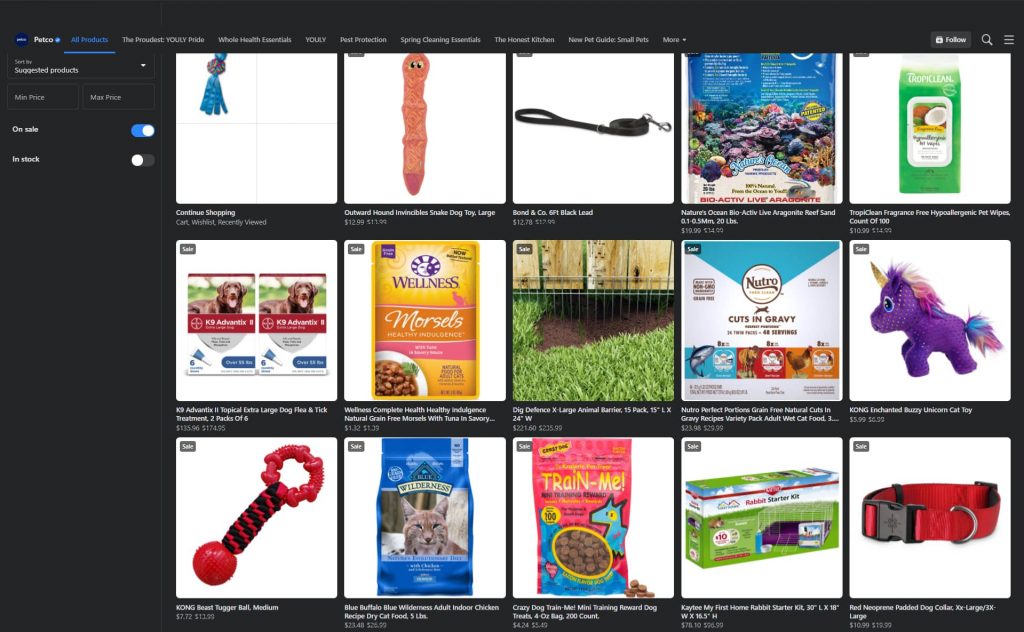We all know Facebook as the biggest social media platform in the world, but the company is ambitious and has expanded its territory to the social commerce field. Over time, it’s implemented Facebook shop, Facebook marketplace, and Instagram shop, all fall under the umbrella term “Facebook social commerce”.
What does this mean for you as a seller? How do Facebook shops work and how can you take advantage of them? Time to get down to brass tacks.
For more social commerce insights, check out our full guide: Social Commerce In A Nutshell – Your Pocket-Guide
First of all, we need to understand what social commerce is. In essence, it is a subcategory of eCommerce that involves social media that supports easy social interaction and user contributions to assist online buying or selling. The number of US social commerce buyers grew by 25.2% to 80.1 million in 2020 and is projected to grow another 12.9% to 90.4 million in 2021.
Needless to say, it is a fast-growing industry, and Facebook took the opportunity right away to secure capital expansion. As of now, the giant has dished out 3 sub-platforms for users to make and spend money: Facebook shop, Facebook marketplace, and Instagram shop.
01. Facebook shops
For you as a seller, it is a customizable storefront where you can list your products, your collections and bring your brand to life. You can post ads for your Facebook store to reach more potential customers, as long as they’re on Facebook. If you have a Shopify store, you’d be happy to hear that you can connect it to your Facebook page and synchronize products and collections on your Facebook shop.
For customers, it is a convenient outlet where they can browse and buy your products without having to leave the site. Facebook also provides suggestions from similar stores so consumers have a more diverse pool to choose from.
Moreover, Facebook shops are integrated with pages, it’s much easier for sellers to form a connection with buyers through posts and stories they want to tell. Customers in turn follow the page to see more of the brand.
Example
To make it simpler, let’s imagine Kathy, a young woman with a pet Golden Retriever. One day, the good boy drops his favorite chewing toy into the sewer, so Kathy needs to buy him a new one. What does she do? She logs in to Facebook, searches for Petco, and browses for new toys from their shop section. And voila, her four-legged friend now has a new toy that he will not bring near a sewer again.

02. Facebook marketplace
Facebook marketplace works similarly to eBay, where users can post product listings and browse one another’s. It’s mostly reserved for secondhand goods from consumers, but it’s not rare to see a merchant there.
If you are a rather lowkey merchant or you have just started your business, this is a great way to gain an organic customer base.
Example: Kevin is an average university student who enjoys music. However, he can’t blast his favorite tunes in the dorm all the time, so he needs to buy a pair of headphones. Since he doesn’t have much money, it’s best that he buy a secondhand pair.
So all he needs to do is go to Facebook marketplace, type the name of the headphones he wants to buy, and look for one from a trustworthy user. He can either meet up with the seller or tells them to ship it to him. It’s as simple as that.
03. Instagram shop
Facebook bought Instagram in 2012 at $1 billion. Back then, Instagram had only 13 employees, so this was a piece of shocking news for everybody. But it turned out to be one of the best investments made since Instagram now generates $20 billion per year for Facebook.
To put it simply, Instagram shops can be considered an extension of Facebook shops. It functions similarly to Facebook’s, only on a different platform. That said, it doesn’t have to robust design and collections merchant can put on their Facebook shops, but does offer customers the convenience of browsing and buying without leaving the app.
04. Why choose Facebook social commerce?
It’s free
Zuckerberg has made it easier for sellers to join the game by charging no initial fee when opening a Facebook store. This is great for when you just started and have little to no capital or funding.
That said, the site has to make money, so there will be fees when customers buy something from your shop. In order to allow the buyers to complete transactions, you’ll need to use Facebook’s payment processing product – Check out, and they’ll collect 5% of your total shipment, or $.40 for those under $8.
You don’t need to have an online store or use an eCommerce platform beforehand
Like mentioned before, you can sync your Shopify store with your Facebook shop for easier product management. But if you don’t have one, that’s fine, you can still open a brand new Facebook shop with just as many functionalities as an integrated one.
Convenient for customers
Many consumers hesitate to buy stuff from brands’ main sites because it can be a hassle. They will have to fill in their payment and shipping information every time they buy something. Facebook’s Checkout takes care of that for them by remembering and auto-filling their payment and shipping details for just about any vendor that’s on the platform.
Moreover, since Instagram is a part of Facebook, the 2 platforms share 1 shopping cart. Customers can then complete the purchase on Facebook for a product they saw on Instagram. Both these perks will ensure a higher purchase rate.
Popular suggestion
You can gain more exposure through Facebook since it suggests similar shops every time customers browse one. If your shop isn’t too niched, this will be a great advantage.
II. Examples of Facebook shop
An introduction to Facebook as a social commerce platform wouldn’t be complete without a few examples of Facebook shops. This is totally essential because only then can you get the gist of what a great shop is supposed to look like. So without further ado, here are 3 Facebook shops and 3 Facebook marketplaces for a bit of inspiration so you can kickstart your business.
01. Manitobah Mukluk: Including products in each post

Manitobah Mukluks sells Mukluks, a type of Canadian original winter boots, and also other types of boots for diversity. Their Facebook shop is a well-rounded one in general, but we’re going to focus on the one outstanding feature that others should follow suit – Shop tag.
Notice the bottom left corner of the photo, you will see the “Click to View Products”. That is where visitors can click and view the products in the shop; they can then save, share or buy the product from Manitobah Mukluks’ shop right away.
02. Lunchskin: Utilizing collection description

Why use boring brown paper or plastic lunch bags when you can have one that’s beautiful, reusable, eco-friendly from Lunchskins? For a cheap price, you can save the environment and have a much more stylish lunch.
“Save $ while saving the planet: get 5% or more off when you buy a bundle”
“DITCH THE PLASTIC BAG, save $8+ per year by switching to Lunchskins Paper Bags”
“One Reusable Bag replaces 750 plastic bags! SAVE $30+ per year by switching to Lunchskins”
Lunchskins really knows how to utilize collection descriptions to let visitors know that their products are either on sale or how customers can save money by buying in bulk. This makes it extra easy for consumers to decide among their options
03. Ink Meets Paper: A seamless path to purchase

Ink Meets paper is a paper-goods company that sells unique cards and other stationery. It really brings us back to the time of words on cards and paper.
Right off the bat, they have a huge “View Shop” button on the homepage, letting you know they have a Facebook shop you can buy their products from. Moreover, they have also incorporated Checkout into their shop so visitors can buy their cards without leaving Facebook. This increases the conversion rate from potential buyers to actual buyers.
For Facebook marketplace, it depends on the particular product listing by the seller. Of course, there will be consistent sellers with consistently good product listing, but it’s just too diverse and depends on the goods being sold. That’s why we won’t include any examples of them..
That said, if you want more examples to learn from, feel free to check out our other article Top 12 Shopify Facebook store examples to learn from and kickstart your busines.
III. Facebook shops’ best practices to drive sale
Maybe you have a Shopify store to integrate with your Facebook shop, or maybe you don’t. Whatever the case is, setting up your shop is just the very first step. You will need to find a way to make the most of it in this era of social media.
01. Create a voice for your brand
89% of US consumers are more likely to switch to brands that support a cause, and 83% of buyers think of brand values when considering a purchase. That’s why it’s important for your brand to have a voice, a personality.
If your entire business is dedicated to a cause like protecting the environment or helping certain demographics by delegating 10% of your profits to organizations, etc. it’s imperative that you make it known. Post regularly about what your brand is all about. This will give your Facebook shop more online presence, and more likely to catch the attention of like-minded consumers.
Related reading: How To Create A Winning Facebook Ad Landing Page (Full Tutorial)
But if your store doesn’t revolve around such a cause, you will need a USP (unique selling point). You can be a funny store that becomes a phenomenon among Internet users like Wendy’s. Kudos to whoever runs Wendy’s Twitter, they really made a name for the brand for tweets like this.

02. Try User-generated content (UGC)
One of the most successful UGC campaign is the #shotoniphone by Apple. In order to promote the camera quality of the iPhones, Apple invited users to showcase what they have filmed with an iPhone. Not only did they get a staggering amount of content from customers FOR FREE, the hashtag also became somewhat a meme that people add to the end of funny clips.

UGC can significantly increase your store’s exposure, while also creating a sense of community where customers share their experience with your product or service. Word-of-mouth is definitely something to take notice of in the social media era, so take advantage of that!
03. Make the most of your customers’ review
Encourage your buyers to leave reviews! Many people already have the habit of doing so, and they even post your products on their Facebook or Instagram. You can totally reach out to them and repost their photos on your own page (if it’s a good review of course). Not only does this make other people associate your brand with positivity, but it also deepens your connection with the customers who left the reviews, creating a loyal customer base.
And if you ever get negative reviews, don’t be discouraged. Learn from it, and promise your audience to improve the product/service you sell. It’s always a good idea to listen to what customers want!
04. Chatbot
When your brand grows bigger, you will undoubtedly get more visitors. You can’t make the time to talk to every one of them and answer all of their questions, so you will need someone to do it for you. And who does the job better than Facebook’s free, automated messages? The process is really easy, and you can pre-program FAQs into Messenger so visitors can get their questions answered fast. It will be a worthwhile investment for sure.
Maybe you can even take it a step further if you work in the fashion or makeup industry. Take a look at this example from Prada implementing AR (augmented reality) filters for consumers to try their products on with a phone.

05. Utilize data and statistic
Facebook tracks their users really well, some even find it creepy. Facebook for business does an exceptional job of providing you with visitors’ data and statistics. With Facebook’s tools, you can find out which posts do well and vice versa, what type of content gets the most interaction, what time of day are visitors most active, and so on.
This will be a most effective companion when running a Facebook shop. There will be many sections to look at, so take your time getting used to all of them, you won’t be disappointed.
06. For Facebook marketplace
As the name suggests, it’s a place for users to trade and sell products. These are mostly people with a specific need in mind, so the only tip from us is to be as detailed as possible. Choose the right category for your products, be clear about pricing, include delivery/shipping if you can. You can only succeed in the Facebook marketplace if you take the time to polish your product listing.
In a nutshell
So that was a full introduction to Facebook social commerce to help you succeed on the biggest social media platform as a merchant. What was the best tip you took away from our article? Whatever it is, do keep all of the best practices in mind, and running the business will be easier, even for a little bit.
Don’t hesitate to check out our other articles for more information on how to effectively operate a store on any eCommerce or social commerce platform!